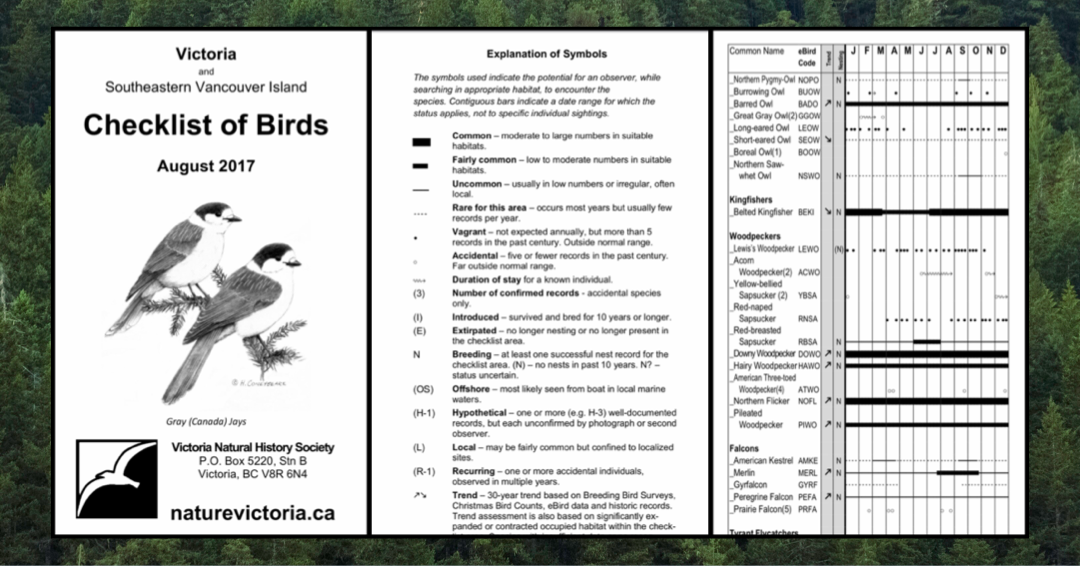Before I get started, I want to acknowledge that I’m publishing this on Friday, September 30, which is Canada’s National Day for Truth and Reconciliation, a time to honour the children who didn’t come home and the survivors of residential “schools”, along with their families and communities.
If you are Indigenous and you’re here for a bit of nerdy, lighthearted fun, then please skip ahead to the next paragraph. If you haven’t been directly impacted by the residential school system and you aren’t sure how to direct your energy today, please consider heading over to the Indian Residential School Survivors Society for educational resources and links to donate.
Ok. Let’s rewind a little. Do you remember how I said that this project was inspired by the Checklist of Birds published by the Victoria Natural History Society? There’s an excerpt below to give you the flavour of the document, and you can find the whole thing here. It’s an excellent resource!
I’m sure many of you have figured it out, but there’s a lot going on in that one image and I know someone out there is wondering how the hell to pronounce JFMAMJJASOND. So. The graph on the right has a line for each bird, showing how common or uncommon that bird is for each month of the year. The thicker the line, the more common the bird. The Belted Kingfisher, for example, is commonly observed year-round, but you’re slightly less likely to see it in April, May, and June.
Image description below.1
The idea for these socks was to pick a handful of birds and then incorporate the corresponding lines from the checklist into the sock pattern. Having already put a lot of time and enthusiasm into developing the colours, I immediately cast on for a sock. I’m not a designer, I just figured I’d wing it (har har) and have fun and maybe learn a thing or two that would be helpful for Andrea when she did the real design.
“Cast on” is knitting speak for creating the first stitches so you can start knitting a thing. The next bit may be jargon-heavy, my apologies if you’re not a knitter and this sounds a little like the wah-wah of Charlie Brown’s teacher.
We knew they were going to be toe-up socks, because that’s the best way to control exactly how much yarn you use for a pair of socks. Starting at the toe and knitting upwards means you knit the foot and heel first. You can make sure they’re the right size for your feet, and after that you knit the leg until you’ve used as much yarn as you want. Generally, no one gives a hoot (look at me with the bird puns) if the cuff is an inch longer or shorter.
This is in contrast to top-down socks where you have your choice of either making them the right size to fit your feet, or using exactly four birds worth of yarn, but not both. (Unless you’re very lucky. Someone out there will have feet the exact size of 2.5 birds, but that shouldn’t be a pre-requisite for this pattern.)
Image description below.2
So toe-up was the way to go. I cast on and starting knitting some socks. I started with the one on the left, and you can see that initially I had the two narrower stripes at the bottom and the wider stripe on top. I didn’t love the position of the textured stitches inside the colours, so after two birds, I cut the yarn and starting working from the other side, putting the wider stripe at the bottom.
You can also see I played around with adding “feathers” at the colour changes, by slipping every other stitch in the first row of the new colour. Cute idea, but not a winner.
One important check for these socks was to see how many rows high that wide stripe was going to be. I’ve dyed enough yarn to have a good estimate, but it was important that there be enough rows to work the textured pattern. Conclusion: yes, it’s fine.
Eagle-eyed readers will notice that this isn’t the final version of the yarn. I did make a few more tweaks to the colours before passing off the yarn to Andrea to create the final design. On the surface, her design looks similar to what’s pictured above. I mean, they’re socks. There’s only so different they can be and still be considered socks. But the final design takes them to the next level. Andrea’s attention to detail is part of what makes her such an excellent designer and I think that really shows through in this project. More on that next time.
Excerpts from “Victoria and Southern Vancouver Island Checklist of Birds” published by the Victoria Natural History Society. Three pages are pictured: the cover page, an explanation of the symbols, and a sample page showing the annual frequency of sightings of some owls, a kingfisher, woodpeckers, and falcons. Reproduced with permission from VNHS. If you’re still wondering, JFMAMJJASOND is pronounced JanuaryFebruaryMarchAprilMayJuneJulyAugustSeptemberOctoberNovemberDecember.
An alpha test version of the Checklist of Birds socks. It’s a pair of hand knit socks, each with four groups of three stripes that each represent a different bird. About halfway up each sock you can see a sort of pale puffy thing sticking out the sides. One the left sock, that is the sides of the heel. On the right sock, that’s the waste yarn I placed there until I get around to knitting the heel.






